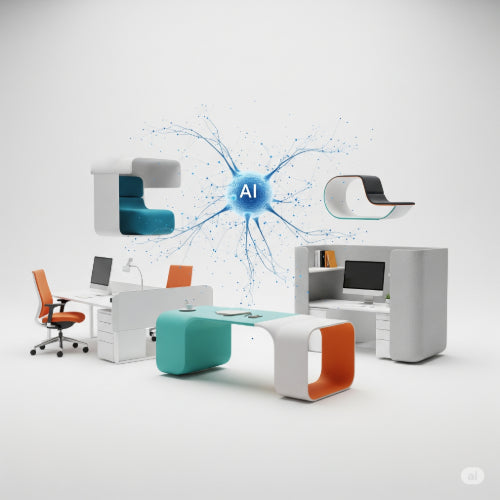Beyond the Ergonomic Chair: How Artificial Intelligence Is Revolutionizing Office Furniture Design
For decades, office furniture has aimed for functionality and, more recently, ergonomics. But with the advent of Artificial Intelligence (AI), we're witnessing a profound transformation in how our workspaces are designed, built, and interact with us. AI isn't just optimizing; it's revolutionizing office furniture, making it smarter, more personalized, and deeply integrated into the modern work experience.
This isn't about science fiction. AI is already empowering designers and manufacturers to create furniture that doesn't just hold our laptops but actively enhances our well-being and productivity. Here's how:
1. Hyper-Personalization: Furniture That Knows You
Gone are the days of one-size-fits-all office setups. AI is enabling a level of personalization previously unimaginable:
-
Adaptive Ergonomics: Imagine a chair that learns your posture habits and gently reminds you to adjust, or a desk that automatically raises to your preferred standing height as you approach. AI-powered chairs use built-in sensors to monitor your sitting position in real-time, offering feedback or making subtle adjustments to support optimal spinal alignment and reduce discomfort.
-
Individualized Workspace Settings: AI can remember your preferred lighting, temperature, and even ambient sound levels. When you sit down at a smart desk, it can automatically adjust these elements to create your ideal micro-environment, boosting focus and comfort.
-
Predictive Maintenance: AI can analyze usage patterns and sensor data to predict wear and tear on furniture, signaling when maintenance or replacement might be needed, extending the lifespan of your investment.
2. Data-Driven Design and Space Optimization:
AI's ability to analyze vast datasets is transforming how office layouts are conceived and utilized:
-
Optimized Floor Plans: AI algorithms can process office dimensions, employee movement patterns, and team collaboration needs to suggest the most efficient and productive layouts. This ensures every square foot is maximized, reducing wasted space and facilitating better workflows.
-
Dynamic Space Adaptation: In hybrid work models, AI can analyze real-time occupancy data to identify underutilized areas. It can then recommend converting these spaces into collaboration zones, quiet focus areas, or even temporary hot desks, allowing the office to adapt fluidly to changing needs.
-
Virtual Prototyping: AI-powered design tools allow architects and furniture designers to create and simulate 3D models of furniture and entire office layouts. This enables rapid iteration and testing of different scenarios, identifying potential issues and optimizing designs long before physical production begins, saving time and resources.
3. Enhancing Health and Well-being:
AI-integrated furniture is becoming a silent guardian of employee health:
-
Posture Correction and Movement Prompts: Smart chairs can detect prolonged static postures and prompt users to move or stretch, combating the negative effects of sedentary work. Some advanced systems can even track micro-movements to assess stress levels or fatigue.
-
Environmental Control Integration: Smart desks and chairs can connect with the broader office's intelligent building systems, adjusting lighting and climate based on individual presence and preferences, contributing to a healthier and more comfortable indoor environment.
-
Biometric Monitoring: Future advancements could see furniture integrating biometric sensors to monitor heart rate or stress levels, providing personalized insights and interventions to promote employee well-being.
4. Sustainability and Efficiency:
AI isn't just smart; it's also green.
-
Material Optimization: AI can analyze the environmental impact of various materials, helping designers select eco-friendly options, reduce waste in production, and optimize logistics to minimize carbon footprint. It can even suggest sustainable alternatives like bamboo or recycled plastics.
-
Energy Management: By optimizing space utilization and controlling integrated smart features, AI-powered furniture contributes to overall energy efficiency within the office, reducing operational costs and supporting sustainability goals.
The Human-AI Partnership in Design:
It's important to note that AI isn't replacing human designers; it's augmenting their capabilities. While AI excels at processing data, identifying patterns, and generating efficient solutions, human creativity, empathy, and aesthetic judgment remain indispensable. The future of office furniture design lies in the powerful synergy between human ingenuity and artificial intelligence, creating workspaces that are not only functional and efficient but also inspiring, comfortable, and truly adaptive to the diverse needs of the modern workforce. The office is no longer just a place to work; it's an intelligent partner in productivity and well-being.







